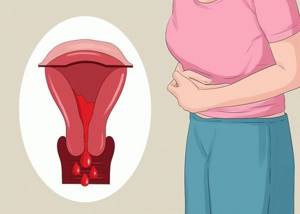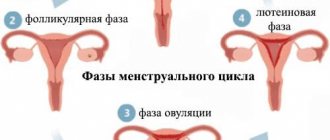Menstrual bleeding begins in the fair sex in early youth and accompanies them until almost 50 years of age (and for some this process lasts even longer). The monthly cycle (after the first 2-3 years after appearance) becomes stable. A woman calculates the approximate timing of the next menstruation, and when there are delays or her period comes earlier than she expected, she begins to worry.
Each of us has our own norm for the interval between menstruation. Let's look at when you shouldn't worry about minor deviations, and when you need to see a doctor.
- How is the cycle between menstruation calculated?
- How many days between periods is normal?
- How many days are there between ovulation and the start of your next period?
- Small cycle between periods
- Long break between periods
- Bleeding between cycles: what to do?
How to correctly count the cycle between menstruation
Sometimes young girls, due to inexperience, count the time of the expected onset of menstruation according to a certain calendar date. For example, in September the “red days of the calendar” came on the 2nd - and they wait for them on the 2nd in October and get scared if this does not happen.
In fact, each new monthly cycle begins on the first day of spotting. The break between this first day and the first day of the next menstruation is the length of the cycle. This interval is different for everyone. It may be equal to:
- 24 days;
- 28 days;
- 31 days.
All these are variants of the norm. You can find out which cycle between periods is considered normal by looking at a medical school textbook. If the interval between the first days of your cycles is from 21 to 35 days, and this always happens with slight deviations, everything is in order. But it also happens differently. Knowing how to calculate the cycle correctly, you can determine whether there are any malfunctions in the reproductive system. You should count every month, for which you need to get yourself a pocket calendar and mark the first day of the appearance of spotting there.
Be a donor
You cannot donate blood during your period and for five days after. Who can become a blood donor? . About 500 ml of blood is already taken from donors. If you lose even more, there may be dangerous health consequences.
In addition, during and after menstruation, women may have lower hemoglobin levels, and this is very important for the donor. By the way, they say that it is precisely because of menstruation that women tolerate donations more easily.
They say that hormones change the vocal cords. They become thicker, it is more difficult to produce a voice, and as a result, singing during menstruation can lead to loss of voice. In one study, Perceived effects of the menstrual cycle on young female singers in the Western classical tradition. checked the artists of the Sydney Conservatoire. It turned out that women notice that it is more difficult for them to sing in the first days of the cycle, that their voice becomes worse. The listeners (vocal teachers) did not see the difference.
And in a study that measured the characteristics of voices, they actually found a difference: during menstruation, the voice decreases. Do Women's Voices Provide Cues of the Likelihood of Ovulation? The Importance of Sampling Regime. , it is more difficult to hit high notes. You can still sing (otherwise it would be like professional vocalists would work), but you should be careful: drink chamomile tea and do not overstrain your ligaments, postponing experiments for later.
What should the cycle be like between periods?
How many days should pass between periods? There is no clear answer to this question. Reason: every woman’s body works in its own way, so everyone’s cycle lasts differently.
On average, it is believed that the duration of one cycle is 28 days. This is exactly what birth control hormonal pills create an “artificial cycle”. However, in life everything is far from being so ideal. Gynecologists accept cycles with intervals of 21 (the shortest) to 35 (the longest) days as normal. These intervals allow the reproductive system to carry out the entire process of preparation for conception and implantation of the embryo without disruption. During this period, the woman’s body manages to:
- “grow” a dominant follicle;
- rupture it and release the mature egg;
- prepare a “lush” layer of endometrium in the uterus;
- to support pregnancy.
If significantly more or less time passes, and the break becomes shorter or longer, it means that some processes are going wrong. The cycle should be such that the numbers from 21 to 35 days are observed. Of course, one-time failures are possible - doctors in such cases attribute violations to:
- ARVI;
- exacerbation of chronic diseases;
- change in climatic conditions;
- stress.
But if the failure recurs, be sure to go to the antenatal clinic. It is necessary to be examined.
The main reasons for frequent periods
A woman's menstruation appears regularly - usually once every 28-29 days, but this interval can vary - from 21 to 35 days (the American Association of Gynecologists suggests periods from 24 to 38 days). The duration of “bloody days” is usually from three to seven days; anything more or less is pathological.
Menstruation can be called frequent if it comes more often than once every 21 days. The condition is called polymenorrhea. In some cases, you have to deal not with frequent periods, but with menstruation and bleeding during the cycle. It is sometimes quite difficult even for a specialist to distinguish between the conditions.
Hormonal disbalance
The entire reproductive system of a woman is under the control of hormones. Changing their ratio or absolute readings leads to various malfunctions that can result in polymenorrhea.
Frequent periods are allowed during puberty, in the first two years from the start of menstruation, while the girl’s body adapts. However, in these situations it is necessary to differentiate between frequent menstruation and juvenile bleeding. The latter are abundant, long-lasting, accompanied by a decrease in hemoglobin levels.
Hormonal disruptions and, as a consequence, frequent periods, in most cases occur against the background of stress, emotional overload, and during the period of menopause.
The menstrual cycle is normal
Polymenorrhea can occur when taking some hormonal drugs, especially oral contraceptives in the first three months - the adaptation period.
In general, all conditions that can affect the level of sex hormones can result in menstrual irregularities such as frequent periods. For example, you can often find the following:
- sudden weight loss;
- perhaps some time after childbirth - two to three months;
- thyroid diseases;
- some gynecological diseases, for example, hormone-producing tumors.
And here is more information about what can lead to intermittent periods.
Tumors
Frequent periods, which are difficult to distinguish from bleeding or intermenstrual spotting, can occur with the following tumors of the reproductive system:
- uterine fibroids;
- endometrial polyps;
- ovarian cysts;
- formations on the cervix.
They can be detected even during a routine gynecological examination, and confirmed using ultrasound and colposcopy.
Pregnancy
In the early stages, pregnancy may proceed unnoticed. At the same time, some women mistake the threat of interruption for menstruation, which may even approximately coincide with the expected days. Therefore, if the discharge is somewhat unusual in nature, for example, it began quickly and ended quickly, or is only spotting in nature, pregnancy should be excluded.
This can be done at home using a standard urine test. But it is more informative to take a blood test for hCG, which already shows a reliable result from the 10th day after conception. If pregnancy is confirmed, even with a weakly positive test, you should consult a doctor. Bloody discharge against this background is a sign of pathology, for example, threat of miscarriage, non-developing, ectopic, etc.
Watch this video about the causes of bleeding in early pregnancy:
Other gynecological problems
Frequent periods may portend various diseases of the reproductive system. In this case, they may be a consequence of hormonal imbalance or represent acyclic discharge, which can be easily confused with menstruation. Most often, such failures are observed in the following pathologies:
- endometriosis;
- inflammation of the appendages and uterine cavity (endometritis);
- polyps of the uterine cavity, cervical canal and cervix;
- malignant tumors of the body and cervix;
- ovarian cysts.
When does ovulation occur after menstruation?
The length of the cycle depends on whether (or whether) it occurs at all. Normally, most often 14 days after the egg leaves the dominant follicle into the abdominal cavity, menstruation begins. There should be 14 days between ovulation and menstruation. Normally, minor deviations are possible within 1-2 days.
If you have a normal cycle of 28 days, but for some reason earlier - on the 11-12th day, your period will come on the 25-26th day of the cycle. This happens after successful treatment of diseases, when the body recovers well and quickly. Another reason is a long vacation in a warm climate, at the sea or in mineral springs. Menstruation occurs a little earlier than usual - there is no need to be afraid of this, unless it comes before 21 days.
The second half of the cycle lasts two weeks, but the first can take longer - for example, this month you have suffered serious stress. The egg matures slowly, the menstruation “collects” only on the 31st-31st day. All these are variants of the norm.
Perhaps your cycle is always 21 days. A short cycle is typical for young girls. The main thing is to make sure that it is regular. A month is also good if this always happens. The cycle lengthens slightly in adult women with established menstruation. Closer to menopause, the cycle can lengthen to 40-48 days.
Treatment of frequent periods
Since frequent periods are not an independent disease, before starting treatment it is necessary to find out what ailment provokes them.
Therapeutic tactics, first of all, depend on how long ago menstruation came too often. If menstruation is disrupted for the first time, and the woman has no signs of gynecological pathology, it is permissible to wait for the next menstruation. If it arrives at the usual time, we can assume that the body has coped with such a violation on its own.
Frequent menstruation repeated over several cycles requires detailed examination and treatment.
Frequent periods after 40 years usually signal the imminent approach of menopause and are accompanied by other pathological signs of hormonal dysfunction. It is impossible to cure a woman from menopause, but you can relieve her of the negative symptoms that accompany this transition. Adequate hormonal therapy and symptomatic treatment of concomitant disorders of the nervous, metabolic-endocrine and psycho-emotional systems come to the rescue.
The presence of infectious inflammation in the uterus and/or appendages requires antibacterial and anti-inflammatory therapy.
The most popular cause of frequent periods remains hormonal dysfunction, so most often they resort to hormonal therapy to treat them. Hormonal drugs are selected only after a laboratory study of the level of basic hormones and an ultrasound examination of the pelvic cavity. According to the results of the examination, a suitable combination of estrogens and gestagens is selected for each patient so that it corresponds as closely as possible to the physiological one.
The determination of ovulation is of decisive importance in treatment, since sometimes frequent periods are a consequence of the anovulatory cycle, when the egg does not leave the follicle, but remains inside it longer than expected. As a result, menstruation sometimes becomes not only frequent, but also abundant. With anovulation, the menstrual cycle becomes single-phase, which leads to infertility. In such a situation, treating frequent periods involves restoring a two-phase cycle and stimulating ovulation.
Any young woman should remember that sometimes frequent periods after unprotected intimate relations can be associated with the threat of miscarriage at a short term or with the presence of an ectopic pregnancy, especially if they were preceded by a slight delay, if they came with pain or deterioration in well-being.
Can ovulation occur immediately after menstruation?
Immediately after the completion of the previous cycle, ovulation cannot occur. After all, the body needs to do hard work to prepare for pregnancy. It takes several days before the new dominant follicle matures.
That is why the first 8-10 days after the start of menstruation are conventionally considered safe days for conception. The calendar method of birth control is based on this.
However, it is impossible to predict how the female body will behave when changing lifestyle and other circumstances. Therefore, theoretically, there are cases when conception can occur on the 7-8th day of the cycle - if it suddenly has time to mature during this time. Then there would be a very short break - less than 21 days.
Regarding fertilization, you need to know the fact that sperm can live in a woman’s genitals for up to 7 days after intercourse. That is, conception immediately after menstruation is possible, and the days that are called safe in the ovulation calculator are conditionally safe.
Malfunctions in the reproductive system occur for various reasons. Between the first and second menstruation, a minimal break is possible in adolescence and during menopausal changes. Premenopause is characterized by an increase in the period between menstruation.
If the amount is produced, then the egg may not mature at all - the cycle will be shortened. The follicular phase (the first half of the cycle, when the eggs in the follicles mature) is shortened. Normally it lasts a little less than 2 weeks. In this case, the interval between the beginning of menstruation and the starting point of the secretory phase will be less than 7 days. The shortest normal cycle is 21 days. If it is shorter, you may have . This can be diagnosed with an ultrasound, but you will need to go through it several times.
Now we know what the break between periods should be - average and shortest. And what can be the longest - but at the same time the reproductive system works normally?
Very frequent periods
“Very frequent” can be considered periods that come in 21 days or less. At the same time, menstruation itself can be heavy and prolonged. All changes occurring in the endometrium depend on the work of the central nervous system (pituitary-hypothalamus) and the ovaries. If their functioning fails, the menstrual cycle is also disrupted. More often, very frequent heavy periods occur due to functional insufficiency of the corpus luteum, when, after normal maturation of the follicle, it is destroyed ahead of schedule.
Frequent periods after 40 years are also more often associated with changes in the hormonal function of the ovaries.
Inflammatory processes in the ovaries negatively affect the menstrual cycle. In addition to very frequent periods, patients experience pain in the projection of the appendages and/or uterus, fever, and poor general health.
Menstrual bleeding is the result of rejection of the overgrown mucous layer (endometrium). If the rejection process does not occur correctly, your periods may change their normal rhythm. Single large or multiple myomatous nodes in the uterus significantly deform its cavity and disrupt the functioning of the uterine muscles, so menstruation may become frequent.
Distinguishing frequent periods from other types of bleeding is not easy. With endometriosis, during the intermenstrual period, scanty discharge may appear, reminiscent of menstruation, and with an inflammatory process in the endometrium, such discharge can be very abundant.
To understand why frequent periods occur without an obvious reason, you need to get tested. A woman can bring a menstrual calendar to her appointment so that the doctor can see how her menstrual function has changed.
To find the cause of menstrual dysfunction, it is necessary to assess the patient's hormonal status. Laboratory diagnostics involves determining the level of hormones (FSH, LH, prolactin, estrogens, thyroid hormones, and so on).
It is also necessary to conduct an ultrasound scan, which can detect inflammation, fibroids, endometriosis and polyps.
Unfortunately, patients with frequent periods do not always seek professional help, especially if frequent periods do not cause inconvenience, that is, they pass without pain and significant blood loss. Meanwhile, sometimes disturbances in menstrual rhythm can lead to serious negative consequences, for example, infertility.
Longest cycle between periods
If your cycle is more than 28 but less than 36 days, don’t worry, everything is fine. A long cycle between periods only means that the first half of the cycle (follicular) is long. Given your hormonal background, the body needs more time to mature the oocyte.
The normal interval between menstruation is up to 35 days. If it is more, this allows one to suspect a violation: the production of hormones is not happening correctly. The cycle lengthens after 45 years, as the process of maturation of the egg undergoes changes.
Women of middle reproductive age may experience oligomenorrhea - a condition when the period between menstruation reaches 40 days or more. This condition requires treatment: the function of the ovaries is impaired, and they may be depleted. Oligomenorrhea is often accompanied by acne rashes on the face, back, and an increase in the hormone testosterone, under the influence of which ovulation is suppressed. The periods themselves are scanty.
Disturbances in the production of hormones by the hypothalamus, pituitary gland, improper functioning - all this can lead to prolongation of the cycle. If you are, it is necessary to conduct an examination, and if any violations are detected, treatment is necessary.
How to normalize a cycle
It is necessary to regulate menstruation only after the cause has been established. Moreover, self-medication or using traditional methods without establishing it is highly not recommended - this can only lead to the disease.
The principles of treating menstrual irregularities are as follows:
- normalization of sleep-wake patterns;
- proper and rational nutrition;
- correction of body weight;
- vitamins - A, E, group B or in complexes, for example, Time Factor, Cyclovita and others;
- if necessary, hormonal therapy;
- mandatory - treatment of provoking/causal diseases after a detailed examination.
And here is more information about why spotting appeared instead of menstruation.
Frequent menstruation not only causes discomfort to a woman, reducing the number of “clean days”, but can also be a symptom of serious diseases. Even occasional such violations should be a reason for a full examination by a gynecologist.
Treatment can consist of changing lifestyle and nutrition, taking vitamins, or it can be serious when identifying diseases. Every woman should keep track of her cycle by recording her menstrual dates in a calendar or phone app.
Bloody discharge between periods
Sometimes there is bleeding between periods, the reasons for which are very different. The main thing to remember is that spotting, even if it occurs without pain and is not abundant, is always a reason to consult a doctor.
24.10.2018
The menstrual cycle is a reproductive mechanism launched in the body of every healthy woman of fertile (childbearing age), ensuring a woman’s ability to conceive and bear a child.
The stability and regularity of this cycle affects a woman’s overall well-being, her condition, activity and mood.
Why women shouldn't lift weights: harmful to health
Not everyone knows why women should not lift weights. A woman is a fragile creature, she has other goals on Earth, she is a mother and a guardian of beauty, why should she physically strain herself? Apparently, based on this concept, the female body was created; it is anatomically not adapted to lifting and carrying loads.
Anatomy of the female body
A woman’s pelvic organs are designed in such a way that they simply have nothing to rest against, or, to put it simply, there is no bottom there. The bladder, uterus, vagina - all of this is attached to the walls of the pelvic bones. In the male body, the pelvic organs rest against the muscles and fascia in the lower part of the pelvis.
All organs of the urinary system, including the uterus, fallopian tubes and vagina, are supported by muscles attached to the bones by ligaments.
And if it is still possible to keep the muscles in good shape with the help of exercises and daily training, then the ligaments remain thin and poorly stretchable.
That is why the tension when lifting weights, increasing the pressure in the peritoneum, simply squeezes the pelvic organs through the bottom. The uterus and fallopian tubes descend.
Hormonal regulation
There are male and female hormones that control the body's metabolism in a variety of situations. The main male hormone testosterone is not only responsible for the functioning of the reproductive system, but also for the growth and strengthening of muscle mass.
In the female body, the governing hormone is estrogen. It regulates many processes, but not muscle growth and strengthening. Women also have testosterone, but it is several times less than in the male body. Thus, it becomes clear why women should not lift weights: this does not strengthen their muscles, but tears them.
Of course, there are examples of women being stronger than men in terms of lifting capacity, such as female bodybuilders. But you need to understand that this category of women is forced to take synthetic testosterone in order to increase the ability of their muscles to grow and strengthen. Having stopped taking the medications, the athlete very quickly returns to a normal state for women.
But it is necessary to stop taking testosterone, because in this case the female body ceases to behave like a male one: the regularity of the menstrual cycle is disrupted, the woman cannot conceive and bear a child, hair begins to grow on her face, her voice becomes rougher and her sex drive disappears.
How much to lift at work
The largest load a woman can lift at work is 10 kg. Although it is better if the load is less.
If your employer requires you to lift more weight, this can be challenged in court. The decision to lift loads at work is formed and approved by the Ministry of Labor, that is, it is a law.
During menstruation, heavy lifting should be completely avoided. What does this mean? This creates additional stress on the uterus (everyone knows that it is a muscular organ), it begins to contract, throwing out blood masses.
Heavy bleeding that gets worse during exercise can cause blood to leak into the ovary or fallopian tube. This circumstance causes endometriosis.
Signs of organ prolapse
Working as a loader or other ways of overloading the female body manifest themselves very clearly. There is pain in the lower back, reflected in the lower abdomen. A woman’s sexual desire disappears, she does not achieve orgasm during intercourse, but feels pain instead.
Air enters the vagina during sexual intercourse, causing discomfort to the woman. The regularity of the menstrual cycle is disrupted or periods disappear completely. You can forget about pregnancy in such a situation.
Causes of pelvic organ prolapse
Pelvic organ prolapse is the main reason why women should not lift weights. But there are a number of factors that are not related to carrying heavy loads, but lead to exactly the same symptoms:
- Pregnancy. But in this situation, although it is natural, it is still a burden. Moreover, pressure on the pelvic organs is exerted by the uterus itself, which becomes heavier day by day.
- Excess weight. The layer of fatty tissue under the skin can reach tens of kilograms, which causes constant stress on the organs. Moreover, the internal organs themselves become covered with a layer of fat, which is also very harmful for them.
- With a sedentary lifestyle, the pelvic organs, and most importantly, the muscles that support them, are extremely poorly supplied with blood, and therefore with oxygen and useful microelements. As a result, the muscles weaken and organs prolapse.
Permitted load for women
The risk of prolapse of the uterus and other organs is the main reason why women should not lift weights. Nevertheless, the female body also needs stress, precisely in order to avoid prolapse and the unpleasant consequences associated with it.
Hence the question of how many kg a woman can lift, in principle, so that it is useful and without risk. The answer is simple. Standards for maximum permissible loads for women are developed at the state level and are included in the Labor Codes of all countries. On average, this involves lifting loads from 5 to 10 kg. Of course, a lot depends on the individual characteristics of the body, height, weight, and age of the woman.
Source: https://FB.ru/article/464823/pochemu-jenschinam-nelzya-podnimat-tyajesti-vred-dlya-zdorovya
How does this happen
The functioning of the menstrual cycle depends on the central nervous system and hormonal levels - the balance of sex hormones - progesterone and estrogen, the production of which is responsible for the ovaries. Depending on the hormones produced by the ovaries, hormones of the main gland - the pituitary gland - appear, but if there are few female sex hormones, then the pituitary gland stimulates their greater production, and this also happens in the opposite case.
The pituitary gland, as part of stimulating the normal menstrual cycle (MC), acts in three directions:
- stimulates the release of the follicle, the maturation of the egg in the first half of the MC;
- stimulates the release of the egg and the production of progesterone in the future, if conception has occurred;
- promotes the production of prolactin - to provide the baby with breast milk after childbirth.
The pituitary gland is affected by the central nervous system (CNS) and its department, which corrects the functioning of the endocrine system - the hypothalamus. It is in this area that hormones that inhibit or inhibit, depending on the need, the production of gonadotropic pituitary hormones are not located and are constantly produced. At the head of the entire hierarchy is the cerebral cortex.
Treatment of frequent menstruation
Depending on the course of the disease, therapy is prescribed. Sometimes surgery is prescribed to stop the bleeding. There is no need to be afraid of this procedure. This is necessary to maintain the woman’s health. If frequent periods recur, then it is necessary to carry out hemostatic therapy, sometimes hormonal drugs are prescribed for this.
Next, hormone therapy is prescribed in order to normalize menstrual function, relieve the woman of infertility, and prevent the recurrence of bleeding. For prevention, a course of 3 months is usually used, and then a break.
The doctor gives general recommendations aimed at preserving the woman’s health. Menstruation after menstruation causes a deterioration in a woman’s general condition and leads to anemia. Therefore, the doctor’s goal is not only to stop the bleeding, but also to carry out restorative therapy.
To alleviate the condition, women are prescribed oxytocin and hemostatic drugs (etamzilate, Vikasol A, ascorutin).
To recover, you need to have a balanced diet with foods rich in iron. This is beef, liver, lean pork, pomegranates. It should be remembered that iron is best absorbed in combination with ascorbic acid, and products such as wine and strong tea block its absorption. Sometimes women are prescribed iron in the form of syrup. It is better absorbed and blood counts return to normal faster. Remember that uncontrolled use of iron supplements is unacceptable. They may cause side effects such as nausea, vomiting, dyspepsia, and black stool. Sometimes it can take several months for anemia to heal.
It is necessary to take vitamin complexes. During the treatment period it is necessary to refrain from fasting. The administration of oxytocin leads to a decrease in the size of the uterus, its tone becomes higher, which prevents bleeding. After treatment, women feel much better and their performance increases.
If the bleeding was not systemic in nature, but was caused by external factors, then it is necessary to exclude their influence as soon as possible. Sometimes heavy menarche is associated with a woman’s mental health, in which case consultation with a psychiatrist is necessary.
Sometimes heavy, prolonged menstruation occurs after the installation of an intrauterine device. This happens in women with a disturbed position of the uterus and in women with altered endometrium. This type of contraception is not suitable for them and should be abandoned. Usually it is replaced with oral contraceptives (OC), they normalize the menstrual cycle. Currently, side effects from taking OCs are minimal, and there are a large number of drugs available. They are used for polymenorrhea as hormone therapy.
Currently, complex oral contraceptives are most often used. They contain estrogens and gestagens. They are divided into single-phase, two-phase and three-phase. In single-phase tablets, the concentration of estrogen and gestagens in each tablet is the same. In two-phase, the amount of gestagens differs in the first phase of the cycle from the second phase, so as not to confuse the tablets in the packaging of two colors. The most modern are three-phase drugs. They imitate the release of hormones in a woman’s body as much as possible. The three-color tablets should be taken as directed. Three-phase drugs cause the least number of side effects, but have one drawback - high cost. There are also non-combined drugs that contain only gestagens.
Ovarian cyst
Often, due to impaired maturation of the follicular component and accumulation of fluid in the cavity, a benign formation appears - a cyst.
It can often be diagnosed in fertile women. The cyst may disappear and appear on its own. The disease occurs in 70 percent of women. Ovarian cysts are classified according to the area of occurrence:
- follicular;
- corpus luteum cyst;
- paraovarian.
If the cyst does not go away within 1-2 cycles or does not disappear after childbirth in pregnant women, it must be removed surgically.
Failures in the cycle, why they happen
We can observe irregular cycles in most women. Few people can boast that their periods begin on the same day of the month. Why is this happening? The first and obvious reason: ideally, the menstrual cycle lasts 28 days. Therefore, if your period began on January 6, then after 28 days it will begin on February 3–4, and then on March 1–2 and March 31–April 1. After all, each month has a different number of days, and the cycle can normally be delayed by 1–2 days. On average, it is expected that the cycle can be from 24 to 35 days. For many women, their cycle changes every month.
Another reason is disorders in the woman’s body. This includes nervous experiences, malfunction of the pituitary gland, ailments of the hormonal system, infections, inflammation, bad habits, excessive physical activity, heavy lifting, taking certain medications, blood diseases, exacerbations of chronic diseases, oncology, etc. The cycle can be affected by unsuccessful surgical interventions for gynecological problems, as well as trauma and damage to the uterus, diseases of the appendages, hypothermia.
Carrying out cosmetic surgeries
Surgery, although cosmetic, is still a risky activity. Which of them can and cannot be done during menstruation? For example, cosmetologists still do not recommend doing such a well-known procedure as mesotherapy.
Mesotherapy
Mesotherapy involves the introduction of a special cocktail of nutrients and other substances under the skin. Cosmetologists advise to refrain from this operation during menstruation. Mesotherapy may not produce results and may be painful.
Botox
Botox injections are now offered by many beauty salons. With their help, wrinkles will be smoothed out and new ones will not appear. But is it worth injecting Botox during your period?
Cosmetologists are against the use of Botox at this time, because, in addition to the painfulness of the procedure, there is a possibility of any side effects at the sites of Botox injections, such as bruises or hematomas. Therefore, reschedule the Botox injection procedure for another period. But at the same time, there are no medical contraindications for Botox during menstrual periods.
Peeling
The cosmetic procedure, peeling, has many varieties. And if you want to do facial peeling and get good results, then refrain from doing it during your menstrual period.
Although you can carry out light peeling these days. But remember that the condition of the skin deteriorates somewhat during menstruation, and therefore do not rush to correct it with peeling, wait a few days.
Shellac
Shellac is a gel polish that has a durable and durable coating. Shellac can be applied in a salon, or you can do it yourself. And since a wide variety of signs are associated with menstrual periods for women, a kind of myth has appeared that shellac should not be done during this period. The myth has absolutely no basis, so feel free to apply shellac during your period.
What types of MC violations are there?
Since the mechanism of the cycle’s functioning is triggered by different parts of the body, the classification of MC disorders is based on where exactly the regulation is disrupted. Cycle failures are distinguished at levels:
- cortex and hypothalamus;
- pituitary gland;
- ovaries;
- uterus;
- thyroid gland;
- adrenal glands
If violations occur in one of the listed departments, the MC also fails. After stressful situations, severe fright or prolonged nervous tension, the pituitary gland suffers, not releasing the required amount of hormone for the cyclic maturation of the egg. There is no ovulation - no menstruation occurs either.
If the function of the hypothalamus is impaired, the ovaries may reduce estrogen production, so egg maturation will not occur within a given cycle. Perhaps the malfunction in the MC is associated with damage to the ovaries up to their fibrosis, which results in a decrease in the number of follicles ready to create an egg during the menstrual cycle. Follicles are formed individually during the period of intrauterine development of the fetus.
How to determine that a failure has occurred in the MC
MC disorders are divided into the complete absence of menstruation - amenorrhea and the presence of scanty discharge of a non-menstrual type at inopportune times.
Another intermediate failure is observed if the intervals between previously regularly occurring menstruation have changed, the intensity of bleeding has increased or decreased, and erratic menstruation has appeared.
The main obvious signs of failure:
- the volume of discharge changes – hyper- or hypomenorrhea;
- the period of discharge has shortened - if previously menstruation lasted for 7 days, now this period has been reduced to 3–4, for example;
- the discharge period has increased;
- The usual rhythm of menstruation has been disrupted - periods appear either twice a month, or there is a 90-day break.
Hypomenorrhea - scarcity of discharge occurs due to decreased activity of the pituitary gland and hardening of the ovaries. Menorrhagia is prolonged heavy menstruation, accompanied by pain and blood loss, lasting up to 2 weeks. Such phenomena occur during the formation of a cycle in adolescence and during hormonal decline in the premenopausal period. At fertile age, such disruptions occur from chronic diseases of the uterus, fibroids and the presence of polyps.
Any cycle disturbances require attention and timely consultation with your gynecologist.
Every girl and woman should know that rarely irregular periods can be considered normal. This is often a serious reason to consult a gynecologist. Why?
Irregular menstruation is a physiological condition characterized by the onset of menstruation at different times, different from the norm, in which the duration of one menstrual cycle is approximately 28 days (can vary from 24 to 35). This condition most often occurs in teenage girls who are just getting better and in older women in the period preceding the onset of menopause. Irregular periods will also be considered normal for women in the postpartum period. All these are physiological causes that do not require special concern or treatment.
The menstrual cycle itself is determined by the presence of female sex hormones. It is with an imbalance of sex hormones that irregular periods are possible, which can be caused not only by the above conditions, which are within normal limits, but can also be a consequence of any diseases. In these cases, contacting a specialist is sometimes even vital. Only he will be able to indicate the exact cause and help eliminate it.
Irregular periods (not normal) can cause:
v heavy physical activity;
v stress, excessive nervous tension;
v depression;
v fatigue;
v lack of adequate sleep and nutrition (especially with various diets and targeted fasting);
v smoking and abuse of alcohol and drugs;
v sudden changes in weather, climate and other external factors (moving, changing jobs, etc.);
v chemotherapy.
To return to a regular cycle, it is enough to eliminate these provoking factors (if possible, of course).
v some diseases of the female genital organs (endometriosis, polycystic ovary syndrome, fibroids, etc.);
v infectious diseases of the body;
v gynecological interventions;
v damage to the cervix.
Here, of course, you will need adequate treatment from a qualified gynecologist and other specialists, which in no case should be delayed. Most likely, the treatment will be comprehensive, with preliminary diagnostics (all sorts of tests, ultrasound, examinations, etc.) and subsequent prescription of medications, procedures or surgery.
In order not to miss irregular periods, which may be a signal from the body about violations, it is necessary to pay due attention to this area. The mother should also teach her daughter to keep detailed records of each cycle. It will be enough to indicate each time in a special notebook or calendar the date of the beginning of the menstrual cycle, its duration, the nature of the discharge (heavy, medium, scanty, etc.) during menstruation, etc. In such a situation, it will be easier for the gynecologist to notice the problem and answer correctly the patient asks why they are going or, conversely, once every few months.
Irregular periods are quite an unpleasant occurrence. They are always foreshadowed by pain in the lower abdomen, severe headache, nausea, mood swings and mood decline without any serious external reasons. To avoid such a disorder in the body, you should carefully monitor the health of all organs and systems, especially the genital area, and regularly visit specialists, a gynecologist in particular; never self-medicate; quit smoking, reduce alcohol consumption to a minimum; eat healthy and wholesome food; learn to relax, etc.
Try to lead - this is the sure path to a happy and healthy future.
Be healthy today, tomorrow and always!
What do menstruation mean? Of course, about women's health. The cycle has gone astray, clots have appeared, the discharge has become abundant or scanty, its color has changed - the body tells you: perhaps you have health problems?
We’ll talk about what periods can tell you on the women’s website “Beautiful and Successful.”
Age reasons
Treatment of frequent periods in women over 40 and in adolescents has its own characteristics. During these periods, increased cycle frequency does not necessarily occur due to gynecological or endocrine diseases.
Adolescence and menopause are considered crisis periods. At this age, women and girls experience hormonal changes in the body, there is a sharp change in mood, fatigue, drowsiness, and pain in the lower abdomen may occur.
In this situation, we are not talking about treatment, but about alleviating the symptoms that accompany frequent menstruation. At the discretion of the doctor, hormonal medications may be prescribed to help quickly stabilize the cycle.
Normal cycle
What regular periods mean is clear to everyone - everything is in order with a woman’s reproductive health:
- Firstly, the onset of menstruation indicates that the woman is not pregnant. This is especially true for unwanted pregnancies.
- Secondly, menstruation indicates that a woman does not have diarrhea, which means that the body continues to produce hormones that are responsible for the functioning of the cardiovascular system.
- Thirdly, during menstruation, a natural process of getting rid of excess iron in the blood occurs in a woman’s body, which eliminates its excessive accumulation and disruption of iron metabolism. An excess of iron in the body leads to a serious disease - hemochromatosis. By the way, to avoid this problem, men are recommended to periodically undergo bloodletting.
Most women with a normal cycle can be said to be lucky in this regard.
Each woman's period has its own “character”.
The main thing is that they are regular and do not bring noticeable discomfort. Regular menstruation is considered to be one that occurs in a timely manner (approximately once a month), and is characterized by a normal amount of discharge and its consistency (not too abundant and not too scanty), a certain color and smell, as well as a normal duration (at least 3 and no more). 7 days).
But sometimes there are periods in a woman’s life when menstruation raises a number of questions:
- What does a delay in menstruation indicate, besides pregnancy?
- What do painful periods, heavy or scanty, mean?
- What do blood clots during menstruation or brown (black, pink) color of discharge indicate?
Any deviations from the norm may indicate that something is wrong with your health.
Permitted load for women

The risk of prolapse of the uterus and other organs is the main reason why women should not lift weights. Nevertheless, the female body also needs stress, precisely in order to avoid prolapse and the unpleasant consequences associated with it.
Hence the question of how many kg a woman can lift, in principle, so that it is useful and without risk. The answer is simple. Standards for maximum permissible loads for women are developed at the state level and are included in the Labor Codes of all countries. On average, this involves lifting loads from 5 to 10 kg. Of course, a lot depends on the individual characteristics of the body, height, weight, and age of the woman.
Delay of menstruation
The absence of menstruation can be natural during pregnancy, breastfeeding or the onset of menopause. But the delay may occur not only because of this.
What else does the absence of menstruation mean? There are several reasons that cause this condition, and they are not always directly related to gynecological problems.
Weight
The cycle may go wrong, and menstruation may not come on time if a woman suddenly loses weight. Very often, modern women are looking for radical ways to combat excess weight and turn to all sorts of quick diets, as a result of which the weight drops sharply and the formation of hormones responsible for the functioning of the ovaries is disrupted. Mono-diets are especially dangerous, excluding meat products, eggs and fish from the diet.
Lack of weight can cause amenorrhea - the complete absence of menstruation.
Why is this happening? Nature has laid down the main function of the feminine principle to procreation. If a woman sharply loses weight (more than 10-15% of the total weight in a short period of time) during prolonged fasting, the body receives a signal that it is impossible to fully bear a child: “hard times are coming and you can’t get pregnant!”
Therefore, the egg cannot be released for fertilization, and the endometrium, which is supposed to receive the egg, cannot be rejected either.
The reproductive system pauses - there are no periods.
Also, a delay in menstruation can occur if you are overweight. In this case, the hormone estrogen accumulates in the fat layer, the excess of which affects the regularity of menstruation - they either stop altogether or begin at the wrong time.
That is, too thin women (below 45-47 kg) need to gain weight, and plump ones need to lose weight. With normalization of weight, the cycle will be restored. A nutritionist and an endocrinologist will help remove this cause of delayed menstruation.
Hormones
What can a missed period tell you about, other than pregnancy? Natural changes in hormonal levels occur with the onset of menopause - the production of hormones in the ovaries ceases. They may also stop being produced if the hormonal system malfunctions at a younger age.
Especially often, women experience cycle failure due to thyroid dysfunction (excessive or insufficient activity).
Therefore, if menstruation is delayed, if a gynecological cause is excluded, the woman is most often referred to have her thyroid gland checked and the condition determined. A referral for examination is issued by an endocrinologist.
Contraceptive drugs
Taking contraceptives can cause a delay in menstruation. This reason is especially relevant at the very beginning of taking hormonal contraceptives, when the body needs time to adjust to the new amount of hormones.
Other reasons
- Menstruation may occur irregularly due to gynecological diseases associated with a violation of the integrity of the inner layer of the uterus, be it spontaneous miscarriages or abortions.
- Menstruation may not come on time due to climate change, after stress and from excessive physical exertion.
Causes of frequent periods
Irregularities in menstrual rhythm can have completely harmless causes. Sometimes, under the influence of external unfavorable factors, the next menstruation comes much earlier than expected. For example, sometimes patients are interested in why menstruation occurs more often after stress, excessive physical activity, or against the background of colds. If menstrual dysfunction has obvious physiological causes, the menstrual cycle usually returns without external intervention once the known triggers are eliminated.
Frequent periods are often caused by an artificial hormonal cause. Sometimes taking drugs based on sex steroids provokes a change in the rhythm of menstruation. This is why menstruation occurs more often during hormonal contraception. Sometimes COCs slightly shorten the intermenstrual interval; this happens if a woman’s own cycle was long (more than 30 days). It is acceptable to shorten the cycle by 4-5 days if menstruation remains regular and is not accompanied by other disturbances. Also, sometimes while taking such drugs, periods become less abundant, but they should not become scanty. If the hormonal drug is chosen correctly, after its discontinuation the cycle returns to its previous natural rhythm.
Frequent periods in adolescents are associated with instability of hormonal regulation, when the young female body has not yet fully adapted to changes in the functioning of the ovaries and the hypothalamic-pituitary system. Frequent periods after 45 years are also associated with the body’s adaptation to conditions of declining hormonal function.
Frequent periods after childbirth are not uncommon. During pregnancy, the hormonal system functions differently, and it takes time for it to return to its previous rhythm after childbirth, so your periods may come more often or less often at first. Breastfeeding women experience frequent periods less frequently after childbirth. To maintain proper lactation, the female body synthesizes the hormone prolactin, which suppresses menstrual function.
If your periods have become more frequent and maintain their “abnormal” rhythm for three consecutive cycles, this should not be ignored. It should be emphasized that early bleeding of any intensity is not always the next menstruation. Often, frequent, heavy periods are bleeding, and scanty, frequent periods mask an ectopic pregnancy.
Among the pathological causes of frequent menstruation, the leading ones are infectious and inflammatory diseases (endometritis, salpingoophoritis), endometriosis, fibroids and uterine polyps, and ovarian dysfunction.
Extragenital pathology can also change menstrual rhythm: diabetes mellitus, diseases of the thyroid gland and liver.
What do heavy or scanty periods mean?
Normal menstruation is characterized by a certain amount of discharge - on average 50 ml of blood. If the volume of discharge exceeds or decreases, they speak of hypermenoria (heavy periods) or hypomenoria (scanty periods).
Heavy periods
The main signs of heavy periods:
- Clots come out along with the blood.
- The largest gaskets have to be changed almost every hour.
- The discharge is accompanied by aching pain in the lower abdomen.
- Menstruation may occur several times per cycle.
- The duration of menstruation is more than 7 days.
What do heavy periods (menorrhagia) mean?
- If your periods were normal before, but this time they are very strong and unusual in nature, then perhaps you were pregnant and had a miscarriage.
- Menstruation may be heavy during an unsteady cycle in teenage girls and menopausal women. During such periods, hormonal balance is established, and there may be malfunctions in the system.
- Menstruation is characterized by particular abundance in various gynecological diseases - fibroids, endometriosis, adenomyosis, and cancer. The exact cause is determined by the gynecologist.
Scanty periods
You should not ignore scanty periods, which are characterized by the following symptoms:
- Small amount of blood (less than 50 ml). This may be a small amount of light brown drops or “smudge” on the gasket;
- Short duration of menstruation - up to two days or scanty discharge during a long period of menstruation - over 10 days.
- Absence of any nagging (spasmodic) pain in the lower abdomen.
- Decreased sexual desire due to lack of estrogen.
What do scanty periods mean?
- First of all, scanty periods indicate a violation of hormonal levels in the body.
- Just as with heavy periods, the cause of hypomenoria can be gynecological diseases associated with dysfunction of the organs of the reproductive system: ovarian dysfunction, tumors (malignant and benign), endometriosis, miscarriage, inflammatory processes of the female organs.
- Disturbances in the functioning of the thyroid gland are also considered one of the reasons why discharge during menstruation may be scanty.
- The same reasons that cause a delay in menstruation can reduce the amount of discharge: significant sudden weight loss or obesity, stress, taking contraceptives.
- Menstruation may be scanty or completely absent during lactation - breastfeeding.
- The amount of discharge may decrease if the body is intoxicated.
Both with heavy and scanty periods, a woman should definitely consult a doctor and get recommendations on how to regulate her cycle.
Professional opinion
Personal aqua fitness trainer, instructor of group programs in aqua aerobics and swimming fitness Sabina Romanova comments:
There is no point in dropping out of active life during your period. In sports, the coach allowed us to skip training only on the first day. This is a training process, and it happens that critical days fall during competitions. Therefore, athletes also train during menstruation, unless the trainer gives less load.
Another important point. Sometimes you need to pay attention to menstrual malaise, nausea and vomiting. All this indicates a hormonal imbalance. A woman suffering from too heavy periods may faint. If bleeding is heavy from cycle to cycle, this may be a sign of excessive growth of the endometrium. Endometrial hyperplasia can manifest itself as bleeding between menstruation. It is important to control how much blood you lose. If the nature of menstruation changes, consult a doctor!
What do periods mean: clots in discharge
The blood during menstruation may contain small clots - particles of exfoliated endometrium and epithelium. This is fine. But the secretions also contain enzymes that liquefy clots.
Therefore, the appearance of large clots is not considered normal. What do blood clots mean during menstruation? Their appearance signals excessive growth of the inner layer of the uterus, which begins to be rejected during menstruation.
- A common cause of strong clots is adenomyosis - the formation of mucous-like tissue in the uterus, which during menstruation begins to be rejected and come out.
- Blood clots can be rejected due to fibroids, uterine fibroids, and polyps on the female organs.
- The appearance of clots is accompanied by termination of pregnancy.
- Clots can also appear due to a blood clotting disorder.
In any case, the diagnosis is made by a doctor; on the website we only point out the possible causes of pathologies so that you do not hesitate to contact a specialist.
Causes of pelvic organ prolapse
Pelvic organ prolapse is the main reason why women should not lift weights. But there are a number of factors that are not related to carrying heavy loads, but lead to exactly the same symptoms:
- Pregnancy. But in this situation, although it is natural, it is still a burden. Moreover, pressure on the pelvic organs is exerted by the uterus itself, which becomes heavier day by day.
- Excess weight. The layer of fatty tissue under the skin can reach tens of kilograms, which causes constant stress on the organs. Moreover, the internal organs themselves become covered with a layer of fat, which is also very harmful for them.
- With a sedentary lifestyle, the pelvic organs, and most importantly, the muscles that support them, are extremely poorly supplied with blood, and therefore with oxygen and useful microelements. As a result, the muscles weaken and organs prolapse.
What does the color of menstrual discharge tell you?
The color and smell of menstrual discharge can tell you about women's health. Normally, they should be a natural, not too bright red color, without a repulsive pungent odor.
Changes in color and odor indicate possible problems in a woman’s health:
- Brown discharge is observed after intrauterine interventions, with scanty periods, and with endometritis. Also, such brown discharge may occur during the initial use of contraceptive drugs. In this case, as a rule, no pain is observed, but there is a characteristic repulsive odor of the discharge.
- Black dark discharge should also alert a woman - they indicate pathological abnormalities. Black spotting in the first days of the expected menstruation may indicate that the woman is pregnant.
- Dark discharge may occur during the onset of menopause, as well as on the days of expected menstruation.
- Malfunctions in the functioning of the body can also be indicated by too thin, watery discharge of a light (pink) color, which is not typical for normal menstruation.
The female body is unique: monthly menstruation indicates that something is wrong with your health. It is enough to pay attention to the regularity, color and consistency of the discharge in order to seek help in time.
Any deviations that raise doubts or questions should be the reason to consult a doctor. Watch your health!
For every woman, a regular menstrual cycle is, first of all, an indicator of health. Normal periods without deviations include those that occur regularly, their abundance, character, intensity and duration are unchanged from month to month. But in practice everything is a little different. Most women face menstrual problems.
Why are my periods bad? A question that concerns almost every third representative of the fairer sex.
If your periods are bad and there is very little blood being released, you should find out the reason. Deviations from the norm, when there is less than 50 ml per day, may indicate diseases of the reproductive system.
Every woman should keep a calendar, where to mark the days, mark what nature and intensity. To find out the exact reason why your periods are not going well, you need to visit a gynecologist. These indicators will help the doctor make a conclusion.
Hypomenorrhea is accompanied by scanty discharge when, during menstruation, a woman loses insufficient blood. Simply put, the volume is less than the physiological norm.
The norm is when a woman loses from 50 to 150 ml of blood. Weak periods can be caused by physiological factors.
During hypomenorrhea, menstruation looks like drops of blood, which can be light in color. In the future, with such scanty menstruation, they may be shortened in duration or absent altogether.
Why do you have scanty periods - reasons:
- Malfunction of the ovaries.
The cause of dysfunction can be various inflammatory diseases, hormonal imbalances, and external factors. Diseases such as oophoritis, salpingo-oophoritis, tuberculosis of the genital organs - these diseases are considered the main causes that can cause scanty periods. - Heredity.
Sometimes, at the genetic level, scanty discharge is passed down the family line. For example, if relatives had bad periods and this was considered within the limits, without affecting conception. In this case, this is not a pathology. - Diseases and congenital pathologies of the uterus
. Weak discharge may also indicate that there is inflammation of the uterus or appendages. Hypomenorrhea can also be caused by: adhesions, scars, taking hormonal contraceptives, and diagnostic manipulations in the uterine cavity. Sometimes the cause is tumors of various types in the appendages, cervix and in the uterus itself. - Hormonal changes.
Failures can occur while taking contraceptives or due to a lack of some sex hormones in the body. But scanty periods can also cause other hormonal problems: diabetes during lactation (prolactin levels increase), problems with the endocrine system, when the thyroid gland produces few necessary hormones. - Psycho-emotional state.
The emotional state affects the entire body, including the reproductive system. Any positive and negative emotions affect the brain, and it transmits a signal to the ovaries, so it can adversely affect their work. - Other reasons:
excessive physical activity, intoxication of the body, overwork, fasting, sudden weight loss, anorexia, injury, lack of essential vitamins, radiation, exposure to chemically harmful substances, acclimatization and infectious gynecological diseases.
Phases of the menstrual cycle
All representatives of the fairer sex, from the moment of puberty, have menstruation every month - bleeding, sometimes accompanied by weakness and pain in the genital area.
Gynecologists, answering the question of how menstruation occurs, explain this regular phenomenon by the characteristics of the hormonal system of women, and according to the processes occurring in the body, they divide the entire cycle into phases.
Desquamation
Experts distinguish 2 phases of the regulatory cycle:
- Ovarian, associated with the maturation of the egg and consisting of 3 stages: follicular, ovulatory and luteal.
- Uterine, depending on the processes in the body during menstruation (all of them occur in the uterus under the influence of hormones secreted by the ovaries). Consists of desquamation, regeneration and proliferation.
Desquamation is the first of three stages of changes in the uterine mucosa (endometrium), which occurs once every month if fertilization has not occurred. At this time, the production of female hormones estrogen and progesterone declines, which impairs the nutrition of the functional layer of tissue.
As a result of this process, dead cells appear. Their rejection and exit from the organ in the form of bleeding is what normally occurs during menstruation. These cells come out completely on the 3rd–4th day of menstruation.

Regeneration
After the release of dead cells of the mucous tissue with menstruation, regeneration occurs - restoration of the epithelium due to the basal layer of the endometrium. The second stage of the uterine phase of the menstrual cycle lasts about a day.
Proliferation
Proliferation is the third stage, which occurs approximately on the 5th day after the onset of menstruation and is characterized by the formation of:
- new epithelial cells with tubular glands by dividing existing ones;
- blood vessels that nourish the glands and epithelium.
This stage lasts up to 2 weeks. During this time, the thickness of the functional layer of the emerging tissue reaches 8 mm.
Weak menstruation: what treatment is used?
To prevent scanty discharge and not wonder why your periods are not going well, you need to visit a gynecologist on time. The specialist will prescribe all the necessary laboratory and medical examinations and tell you about preventive measures.
It is unlikely that you will be able to determine the cause on your own, so it is better not to risk it. A qualified gynecologist will be able to answer the question of why deviations from the norm occurred. If necessary, you may need the help of an endocrinologist.
Also don’t forget that you need:
- Healthy food;
- lead a healthy lifestyle;
- exercise;
- try to avoid stress.
You need to visit an obstetrician-gynecologist at least once every six months to monitor the condition of your body, especially the condition of the reproductive organs.
Sometimes during treatment a woman experiences:
- depression, stress;
- lethargy, apathy;
- frigidity.
In such a situation, sessions with a visit to a psychotherapist are added to the course of therapy.
How to take medications and eat during menstruation
Stop taking medications
What not to do during menstruation
During menstruation, there are restrictions on taking certain medications, especially those affecting blood clotting and hematopoiesis. Analgin and aspirin, traditionally used to relieve pain and relieve unpleasant symptoms of illness, are prohibited. It is better to replace them with paracetamol, ibuprofen or other products that do not contain acetylsalicylic acid or acetaminophen.
Sometimes during menstruation the tolerance to certain drugs used for chronic diseases or prescribed by a doctor to treat an infection is temporarily impaired. Then dose adjustments or drug changes should be discussed with your doctor.










